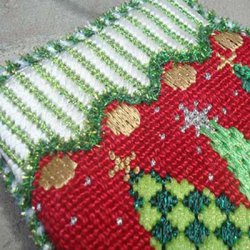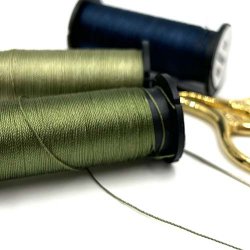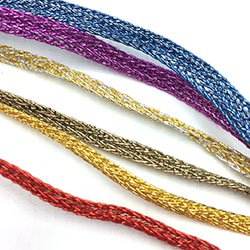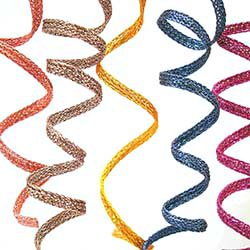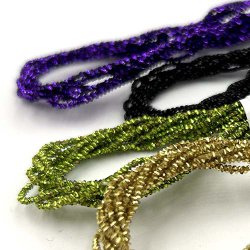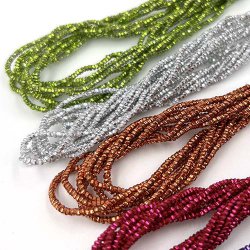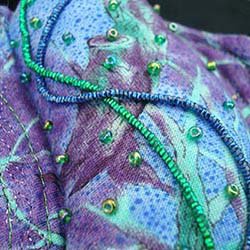-
How To Use Kreinik Micro Ice Chenille
Quick! Name five things that are fuzzy (bonus points for fuzzy metallic things). How about: garland on Christmas trees, legs on spiders, flower centers, bushy eyebrows, other, ahem, hairy things, peaches, caterpillars, lots of bugs actually, baby chicks, moldy cheese, your brain after a long weekend. How many could you list? Nature and life itself are full of texture. It makes things visually interesting and tactile.
You can recreate the fuzzy factor of true life objects with Kreinik's Micro Ice Chenille in your favorite hobby: needlepoint, cross stitch, embroidery, fly fishing, crochet, knitting, weaving. It adds whimsy, dimension, texture, and just plain visual interest to a design.What is Micro Ice Chenille and where can you use it?
- it's a fuzzy metallic
- couch in needlepoint, cross stitch, quilting, crazy quilting for surface embroidery (couch it with a Kreinik Cord or Very Fine #4 Braid, rather than stitch in and out)
- can also use it in long stitches in needlepoint if the canvas is not densely stitched (Micro Ice Chenille just doesn't like going in and out of fabric very much)
- combine it with any other fiber for cording and trims on stockings, ornaments, etc
- crochet little accessories and appliques (wreaths, flowers)
- use it in duplicate stitch in knitting (like a spider!)
To use in weaving:
- Can be used in weft, not for warp (too much stress)
- Weight/Yardage: Kreinik metallic yarns are not measured in terms of weight like wool or cotton yarns are, so measure by yard or meter. Purchase 50-meter cones; or cones of any amount by special order.
- Sett = 5 epi
- Care: Kreinik metallics don't felt, and are inelastic compared to some other types of yarns, so for best results, we recommend testing the threads with the weaving yarns you plan to use before beginning your project.
- Tips from weaver Deb Essen of DJE Handwovens: 1. Pull the thread off the cone horizontally, not from the top, to avoid adding twist to the fiber. 2. Combine with other yarns (rather than use a metallic exclusively) as an accent yarn for best results ("It makes a great, fun fabric"). 3. Test how the textures work together before making your main project: make test swatches if using stretchy yarns with the inelastic metallics, for instance, then use a warm-water wash for the wet-finishing. 4. You may want to experiment with looser sett to vary drapability. 5. Play! Have fun! "I love how the colors pop in sunlight or lamplight and shimmer as the piece is moved."
Content:
Cotton core, polyester metallic
-
How to use Kreinik Silk Serica®
Silk Serica® can be used as is, straight from the reel, as a 3-ply twisted filament silk. It can also be separated and used as a flat silk. Made of 100% pure filament silk, the sheen is so rich and bright, it instantly turns any design into a work of art. Perfect in heirloom projects and designs focusing on different textures.
The most important tip to remember when working with Silk Serica: moisturize your hands with a non-greasy hand cream. This will keep the filament silk from snagging on rough spots.
See Description below for more tips and usage ideas.
-
How to use Kreinik Silk Bella™
Silk Bella™ is the thinnest of the Kreinik silk threads. It is a filament silk with a bright sheen, visible in designs even with it's small weight. It is a beautiful thread when used in any stitch, in any technique. Silk Bella is dyed in colors to match Silk Mori® and Silk Serica®.
Content: 100% pure filament silk
Care
Silk Bella should only be dry cleaned. Do not wash or wet block silk work. Do not use an embroidery hoop with silk thread in hand stitchery, as the rings, markings or folds left in the fabric cannot be removed by washing the piece. Instead, use stretcher bars, Q-snaps, or scroll frames.
Applications
Appliqué (hand and machine), blackwork, costume making, crazy quilting (hand and machine), crewel, crochet, cross stitch/counted thread, couching, doll making (hand or machine), hardanger, Japanese embroidery, knitting, lace making, machine embroidery/bobbin work, machine embroidery/couching, miniatures, needlepoint/canvas work, punch embroidery, ribbon embroidery (hand and machine), smocking, stumpwork, weaving.
Hand Embroidery, Cross Stitch, Samplers, Needlepoint
Silk Bella is ideal for a variety of stitches in samplers, hardanger, crewel, stumpwork, pulled work, crazy quilting, petit point, and needlepoint or canvas work. Use it straight from the reel as a 3-ply twisted thread for tent stitch, satin stitch, kloster blocks and other stitches that showcase its texture. It is similar in weight to a #12 Pearl Cotton. Do not separate strands; use as is, straight off the reel.
Tips on using Silk Bella
- To keep your stitching looking its best, take time to wash your hands before stitching. Use a non-greasy hand cream to moisturize hands and prevent the silk from snagging on dry skin or cuticles.
- Prepare your ground material (fabric or canvas) prior to stitching to prevent the silk from snagging on rough edges. Turn the edges under with a running stitch, or cover the edges with tape.
- Silk Bella® comes on a snap-spool mechanism. Both sides of the spool open; look for the side where the thread end is located. Insert your thumbnail under the cap, and rotate the spool while gently lifting the cap to release the thread (the cap should not pop off). Snap the lid shut to secure the unused portion.
- Use lengths of silk no longer than 45cm (18 inches) for better thread control and reduced thread abrasion from repeated passes through the ground material. Use a needle large enough to 'open' the hole in the fabric to allow the silk thread to go through easily.
- It is important to maintain Silk Bella's twist as it comes from the spool to ensure uniform stitches from beginning to end. Since all of us as stitchers twist our needles a little bit while stitching, apply a slight reverse twist to your needle, or allow your needle to dangle every one or two stitches. This will prevent the softly twisted silk from untwisting or becoming too tightly twisted.
-
Kreinik Braids: Uses and Care
Applications
Uses depend on the thickness of the Braid but include: blackwork, cosplay, crazy quilting, crewel, crochet, cross stitch/counted thread, doll making, fly fishing, hardanger, kids crafts, knitting (by hand), lace making, machine embroidery/bobbin work, machine embroidery/couching, miniatures, needlepoint, plastic canvas, punch embroidery, quilting, ribbon embroidery, serging, silk gauze/Polysil, smocking, stumpwork, tatting, weaving.
Braids are available in several metallic types or effects: Basic (no letter in the color number), Hi lustre (HL), Glow-in-the-dark (F), Vintage (V), Holographic (L), and Corded (C).
Material Content
100% polyester (holographic colors), 65% polyester/35% rayon (regular colors), 62% polyester/38% nylon (hi lustre colors), 64% polyester/36% nylon (vintage colors), 80% polyester/20% nylon (glow in the dark colors)
Care
Kreinik Braids are hand or machine washable and dry cleanable. Cool water is recommended. Do not use bleach. They can also be tumble-dried on low setting. When ironing a finished piece containing Kreinik Braids, do not iron directly on the thread; use a cloth, and do not use steam.
Hand Embroidery
- Kreinik Braids are used alone rather than combined with another thread type in the needle.
- Use them to recreate the color and texture of nature and life, such as glistening snow, luminescent butterflies, glowing moons and stars, polished black leather shoes, shimmering fish or sea life, and more.
- You can also use their light-reflecting properties to create mood in a design; imagine the radiant stardust of an angel, the magical shimmer of a mermaid, or the crystalline coating of a winter's snowfall.
- Of course, you can also use the metallic braids just to bring sparkle, depth, texture and visual interest to any project, whether it is worked in crochet, cross stitch, canvas work, crewel, or embroidery.
- Don't be afraid of adding a light source in a design and replacing a cotton or wool thread for a metallic thread; the effect of combining different thread textures can be more visually exciting than a design worked in a single thread type. With these braids, your creative possibilities are endless.
Machine Embroidery
- Kreinik Braids offer colorful, textured embellishment options, but are best used in bobbin work. The thicker Braids can be couched; to make it easiest, get a Couching Foot for your machine.
- Experiment with tension settings, needles, machine feet and thread set-ups until you get a combination that works for your machine and fabric.
- Using decorative threads with a sewing machine may take a little extra time, but the colors and textures won't disappoint you in the finished project. They can create award-winning, memory-making, dynamic visual effects.
Weaving
- You can use Kreinik Braids in the warp or weft.
- They add gorgeous texture and light.
- The smaller the Braid number, the lighter weight the thread: #4 and #8 are lace/fingering weight, #12 is superfine/fingering, #16 is superfine/baby, #24 Braid is fine/light, #32 Braid is light.
- Kreinik metallics don't felt, and are inelastic compared to some other types of yarns, so for best results, we recommend testing the threads with the weaving yarns you plan to use before beginning your project.
- You may want to experiment with looser sett to vary drapability. Basic colors (no letter in the color number) tend to be softer.
- Weight/Yardage: Kreinik metallic yarns are not measured in terms of weight like wool or cotton yarns are, so measure by yard or meter.
- For weaving we suggest purchasing cones rather than small spools.
- SETT info available by request.
-
Metallic Thread Selection Guide
Which Kreinik metallic thread works best in Cross Stitch? Which Kreinik metallic thread can you use in a sewing machine? These selection questions and more answered below:
CARD MAKING, SCRAPBOOKING:
- Stitching on paper: Cord, Very Fine #4 Braid, Fine #8 Braid
- Ribbons: 1/16" Ribbon, 1/8" Ribbon
COSPLAY, COSTUMING, FASHION:
- See "Hand Embroidery" or "Machine Embroidery" lists (below)
CROCHET:
- Carry-along: Blending Filament, Ombre, Reflective Yarn
- Jewelry: Tapestry #12 Braid, Medium #16 Braid, Canvas #24 Braid
- Bead crochet: Fine #8 Braid, Tapestry #12 Braid
CROSS STITCH:
- Blending Filament (use by itself or combined with other thread like cotton embroidery floss)
- Cord (backstitching, couching)
- Very Fine #4 (on 16- and 18-count Aida or over two threads on 28-, 32-count linens)
- Fine #8 (on 14-count Aida, or over two threads on 28-count)
- Tapestry #12 Braid (12-count fabrics)
- Medium #16 Braid (11-count fabrics)
- 1/16" Ribbon (10- to 11-count fabrics)
- 1/8" Ribbon (6- to 8-count fabrics)
- Cross stitching on unusual materials, like pegboard, screens, etc? Go up to one of our larger Braids, such as Medium #16 Braid, Canvas #24 Braid, or Heavy #32 Braid); the larger the Braid number, the heavier the thread.
HAND EMBROIDERY:
- Stitch in and out of the fabric: Cord (for very fine details), Very Fine #4 Braid, Fine #8 Braid
- Couch for surface embellishment: Medium #16 Braid, Canvas #24 Braid, Heavy #32 Braid, 3/8" Trim, Facets, Petite Facets, Micro Ice Chenille, Wired Braid, 3/8" Trim
- Ribbon embroidery stitches: 1/16" Ribbon, 1/8" Ribbon, 1/4" Ribbon, Easter Grass
- Dimensional, shaped stitches: 3/8" Trim with wire, Wired Braid
KNITTING:
- Carry-along: Blending Filament, Ombre
- Bead Knitting: Fine #8 Braid, Tapestry #12 Braid
MACHINE EMBROIDERY and QUILTING:
- In the needle: Cord, Japan #1
- In the bobbin: Ombre, #4 and #8 Braids, Cord
- Couched: Facets, Petite Facets, Micro Ice Chenille, Ribbons, Braids (all sizes), Wired Braid, 3/8” Trim, Cable, Japan #5, 7
NEEDLEPOINT:
- Blending Filament (if blending with other fibers) (also can be used on 40-count silk gauze)
- Cord (backstitching, couching)
- Cable (3-ply twist for specialty stitches on any canvas)
- Very Fine #4 Braid (blending on any canvas)
- Fine #8 Braid (18-, 24-count)
- Tapestery #12 Braid (18-, 14-count)
- Medium #16 Braid (14-, 13-count)
- Canvas#24 Braid (13-, 12-count)
- Heavy #32 Braid (12-, 10-count)
- Ombre (18-count canvas, or specialty stitches)
- Couched: Petite Facets, Facets, Micro Ice Chenille, 3/8” Trim, Wired Braid, Japan Threads
- Ribbons: 1/16” (24-, 18-count canvas); 1/8” (14-, 13-count); 1/4” (12-, 10-count), Easter Grass (any canvas)
PUNCHNEEDLE:
- Blending Filament (#1 needle)
- Very Fine #4 Braid (#1 and #3 needles)
- Fine #8 Braid (#3 needle)
PLASTIC CANVAS:
- Medium #16 Braid (14 count)
- Canvas #24 Braid (10-count)
- Heavy #32 Braid (7 count)
- 1/8" Ribbon (7-10 count)
MIXED MEDIA, CRAFTS, STRING ART, OTHER FIBER ARTS:
- All fibers
SAMPLERS:
- Cord (backstitching, couching)
- Very Fine #4 Braid (over two threads on 28-, 32-, 36-count linens)
- Fine #8 Braid (over two threads on 28-count linens)
- Cable (long stitches and specialty stitches)
- 1/16" Ribbon (woven stitches)
SASHIKO:
- Very Fine #4 Braid
- Fine #8 Braid
- Tapestry #12 Braid
- 1/16" Ribbon
SWEDISH WEAVING:
- Very Fine #4 Braid
- Fine #8 Braid
- 1/16" Ribbon
- 1/8" Ribbon
TEMARI:
- Fine #8 Braid
- Tapestry #12 Braid
- Japan thread
- 1/16" Ribbon
WEAVING:
- Warp: Ombre, Ribbons (basic colors), Braids (basic colors)
- Weft: Micro Ice Chenille, Ombre, Ribbons and Braids (any color)
-
How to use Facets in needlework
Beads in embroidery create interesting bumpy texture and add 3-dimensional lift. That sounds awesome—until you start stringing a hundred tiny orbs that roll around when you try to pick them up. How many times have you toppled your bead tray, or how many beads have you lost under in the couch, while trying to embroider with them? There's an easier way! We're here to make your bead-life better, with Kreinik Facets.
Kreinik Facets are a bead-like yarn that you couch on the surface of your needlework. They're essentially beads that are already strung together. So you get no mess, no flying beads—only the cool look of 3-D texture without the hassle. On your way to becoming a Kreinik thread expert this year, you will want to explore this fun fiber option. Here's everything you need to know about Kreinik Facets to make your next project as gorgeous as ever.
Five facts about Kreinik Facets- It's faster than beading. Imagine simply laying one strand of beads, rather than threading individual beads one at a time.
- It's a surface embroidery thread, you don't stitch in and out with it like a traditional Kreinik Braid. This actually makes it versatile: you can use it on any size canvas or fabric.
- It comes in two sizes: regular Facets and Petite Facets, which are half the weight of regular Facets.
- It comes in a wired version. Aside from the obvious 3-D effects, the wire holds its shape while you couch it down (ie, great for cursive words).
- You can use it to make interesting cords. Take the red Facets and cord with Kreinik's Micro Ice Chenille in green, for instance, using the Custom Corder tool, then turn the cording into a wreath shape. The Facets look like holly berries.
Where to use Facets
Think of this fun fiber for borders, trims, cording. Use Facets to replicate jewelry, garland, rope-like areas, or any motif where you would normally use beads.
- needlepoint
- cross stitch
- embroidery
- clothing
- quilts
- home decor
How to use Facets
- First, prepare the ends. This is the trickiest part about Facets, but easily controllable. Wrap a piece of tape tightly around the end. Use a large needle or awl to open the hole in your fabric or canvas, and plunge the end to the back of your work. Use the needle or your finger to "close" the canvas/fabric fibers around the Facets.
- Alternate thread-end prep: use a clear nail polish or FrayCheck™ to stop any raveling. After it dries, the ends can be secured as part of your stitching on the surface of your work (no need to plunge to the back).
- Couch Facets (tack them down) using either a matching color of Kreinik thread (like #4 Braid or Cord), a clear monofilament thread, or a contrasting color of any thread (like silk or metallic). What you use to couch them depends on the look you want to achieve in your design. Feel free to experiment and have fun here.
- When finished, either plunge the end to the back (as in #1 above) or use #2 option to finish off the end.



